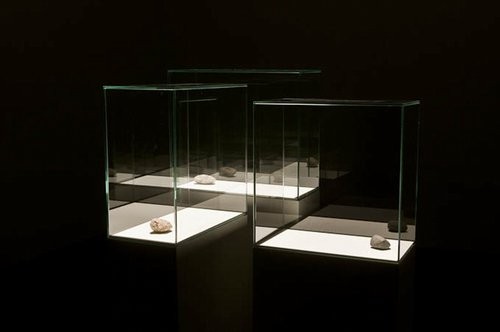Alicja Kwade
24 Apr - 27 Jun 2010
ALICJA KWADE
"Problems of Massive Volumes"
24 April – 27 June 2010
Opening: 23 April at 7 pm
Location:
Ehemalige Tanzschule Rebel, Berliner Platz 23, Münster
Alicja Kwade (*1979, Poland) has in her sculptures—as well as in her installations, photographs and films—long been engaged with different aspects of our value systems and with the issue of abstract concepts such as space and time. The artist lives in Berlin and belongs to a generation of sculptors who have taken up the fundamental approach of the installations of the 1960s, such as Minimal Art, and adapted their principles without pursuing their thematic contents. Above all the artists Robert Morris and Robert Smithson, who specifically in the 1990s enjoyed a reevaluation, represent an important context for regarding Kwade’s works.
Kwade occupies herself with complex scientific theories on the physical property of certain materials, which she then repeatedly attempts to circumvent. Everyday articles and mostly worthless found objects make up her main starting point. Often deploying an elaborate modus operandi, the artist transforms these objects into pieces that suggest the luxurious and the immaculate. They hereby undergo a subtle change in meaning; the objet trouvé becomes a minimal sculpture or, symbolized by its infinite reproduction, a specific historical moment.
The exhibition at the Westfälischer Kunstverein assembles Kwade’s most recent works, whose centerpiece is the video installation “Thoas, Agrios, Gration” (2009). Three canvases are suspended in a pitch-dark room and show shots of rocks that float there in apparent weightlessness. This cinematic staging is supplemented by other sculptural works in the gallery. Kwade’s objects and pictures are mostly based on simple ideas that challenge the viewer’s perceptual world. For what seems “normal” usually proves at a closer look to be a physical impossibility.
The quality and the tension in Kwade’s work lies in creating a telling form and a perfect surface, coupled with an irritating factor that takes us beyond these aspects. With her materially precisely worked out sculptures, she ventures into the field of the natural sciences, although she immerses their materiality and worldliness in a surrealist light. Mirror reflections, repetitions and waves of light and sound generate an atmospheric intensity. Kwade tries to make the invisible visible, the inconceivable conceivable. To do so, she creates forms that are at time poetic, at times absurd, within an otherwise rationally determined reality.
Parallel to our exhibition, The Kestner Gesellschaft in Hannover is presenting a solo exhibition of the artist from 9 April to 24 May. A comprehensive publication with articles written by Kristy Bell, Kathrin Meyer and Katja Schroeder will be published by the Distanz Verlag, Berlin.
"Problems of Massive Volumes"
24 April – 27 June 2010
Opening: 23 April at 7 pm
Location:
Ehemalige Tanzschule Rebel, Berliner Platz 23, Münster
Alicja Kwade (*1979, Poland) has in her sculptures—as well as in her installations, photographs and films—long been engaged with different aspects of our value systems and with the issue of abstract concepts such as space and time. The artist lives in Berlin and belongs to a generation of sculptors who have taken up the fundamental approach of the installations of the 1960s, such as Minimal Art, and adapted their principles without pursuing their thematic contents. Above all the artists Robert Morris and Robert Smithson, who specifically in the 1990s enjoyed a reevaluation, represent an important context for regarding Kwade’s works.
Kwade occupies herself with complex scientific theories on the physical property of certain materials, which she then repeatedly attempts to circumvent. Everyday articles and mostly worthless found objects make up her main starting point. Often deploying an elaborate modus operandi, the artist transforms these objects into pieces that suggest the luxurious and the immaculate. They hereby undergo a subtle change in meaning; the objet trouvé becomes a minimal sculpture or, symbolized by its infinite reproduction, a specific historical moment.
The exhibition at the Westfälischer Kunstverein assembles Kwade’s most recent works, whose centerpiece is the video installation “Thoas, Agrios, Gration” (2009). Three canvases are suspended in a pitch-dark room and show shots of rocks that float there in apparent weightlessness. This cinematic staging is supplemented by other sculptural works in the gallery. Kwade’s objects and pictures are mostly based on simple ideas that challenge the viewer’s perceptual world. For what seems “normal” usually proves at a closer look to be a physical impossibility.
The quality and the tension in Kwade’s work lies in creating a telling form and a perfect surface, coupled with an irritating factor that takes us beyond these aspects. With her materially precisely worked out sculptures, she ventures into the field of the natural sciences, although she immerses their materiality and worldliness in a surrealist light. Mirror reflections, repetitions and waves of light and sound generate an atmospheric intensity. Kwade tries to make the invisible visible, the inconceivable conceivable. To do so, she creates forms that are at time poetic, at times absurd, within an otherwise rationally determined reality.
Parallel to our exhibition, The Kestner Gesellschaft in Hannover is presenting a solo exhibition of the artist from 9 April to 24 May. A comprehensive publication with articles written by Kristy Bell, Kathrin Meyer and Katja Schroeder will be published by the Distanz Verlag, Berlin.

